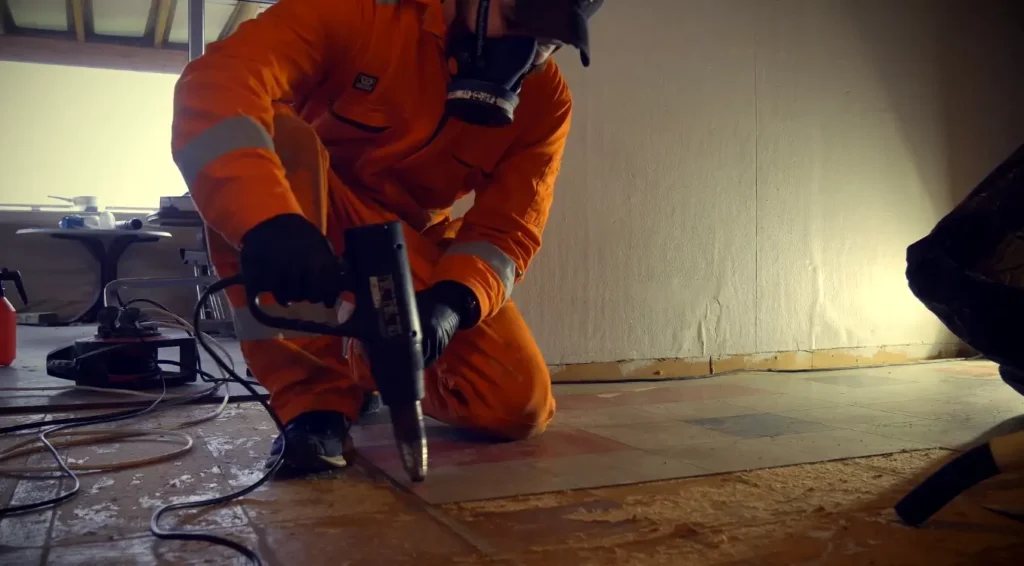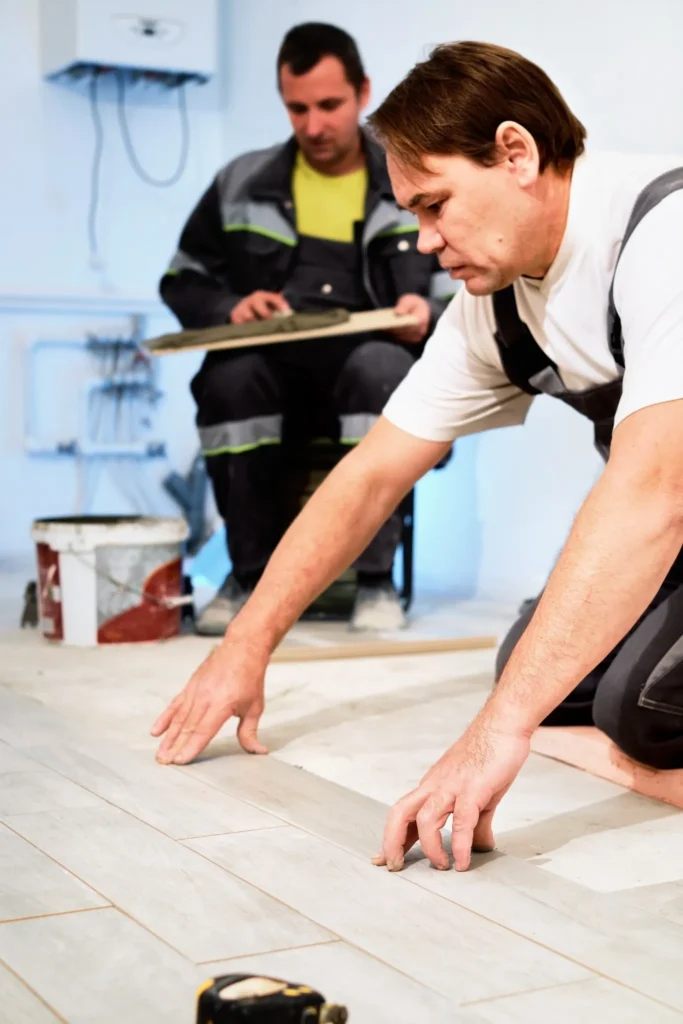Asbestos, a hazardous material, was commonly used in building materials, including vinyl flooring, until the late 1970s. If you suspect your old vinyl flooring contains asbestos, handling the situation with care is crucial. This article will guide you through safely removing old vinyl flooring with asbestos, including preparation, removal steps, safety precautions, and answers to frequently asked questions.
How to Remove Old Vinyl Flooring with Asbestos Safely?
Removing old vinyl flooring that contains asbestos requires careful handling to prevent health risks. First, it’s crucial to confirm the presence of asbestos through testing; if found, hiring a certified professional for removal is advisable, as they have the necessary training and equipment.
If you proceed, wear appropriate personal protective equipment (PPE), including a respirator, gloves, and goggles. Begin by sealing off the area to prevent asbestos fibers from spreading. Use a utility knife to cut the vinyl into manageable sections, and gently lift the tiles without breaking them.
Place any debris into sealed plastic bags labeled as containing asbestos for safe disposal according to local regulations. Always follow safety protocols and consult a professional for the safest outcome.
How to Remove Old Vinyl Flooring with Asbestos from Wood?
Removing old vinyl flooring that contains asbestos from a wooden subfloor is a delicate process that requires careful planning and safety precautions. Here’s a step-by-step guide to help you through the process:
1: Confirm Asbestos Presence: Before beginning, it’s essential to confirm the presence of asbestos. Hire a licensed professional to conduct a test if you need clarification. If asbestos is confirmed, consider hiring a certified asbestos abatement contractor.
2: Prepare the Area: Clear the area of furniture and any items that could be damaged. Seal off the room using plastic sheeting to prevent the spread of asbestos fibers. Turn off HVAC systems to avoid circulating airborne particles.
3: Wear Protective Gear: Equip yourself with appropriate personal protective equipment (PPE). This should include a respirator, HEPA filter, gloves, goggles, and disposable coveralls.
4: Create a Wet Environment: To minimize dust, lightly spray the vinyl flooring with water. This helps to dampen the materials and reduce the likelihood of airborne fibers during removal.
5: Cut the Vinyl Flooring: Use a utility knife to cut the vinyl into manageable sections carefully. Be gentle to avoid breaking the tiles, as this could release asbestos fibers.
6: Lift the Vinyl Flooring: Starting from the edges, gently pry up the vinyl flooring using a putty knife or a flat tool. Work slowly and carefully, lifting the pieces without causing damage to the underlying wood.
7: Dispose of Materials Properly: Place the removed vinyl pieces and any debris into heavy-duty plastic bags. Seal the bags tightly and label them as containing asbestos. Follow local regulations for disposal, which may involve taking them to a designated facility.
8: Clean Up: After the removal, thoroughly clean the area using a damp cloth to capture any residual dust. Avoid sweeping or using a vacuum cleaner, as this can disturb particles and release them into the air.
9: Final Inspection: If you need clarification on the area’s safety after removal, consider hiring an asbestos abatement professional to conduct a final inspection and air quality test.
Always prioritize safety and follow regulations when dealing with asbestos materials. If in doubt, seeking professional help is the best approach.
Removing Asbestos Flooring:

Removing asbestos flooring is a critical process that must be approached with caution and professionalism. Asbestos, a hazardous material commonly used in older flooring products, can pose serious health risks if its fibers are disturbed and inhaled. The first step in the removal process involves a thorough inspection to determine the presence and condition of asbestos.
Hiring a certified asbestos abatement contractor trained in safely handling and disposing of asbestos materials is essential. They will follow strict guidelines to seal off the work area, use appropriate protective equipment, and employ specialized tools to minimize dust and prevent contamination. After removal, all materials must be disposed of according to local regulations to ensure safety. Proper removal protects the health of occupants and increases the value of the property.
Vinyl Sheet Flooring
Vinyl sheet flooring is a popular choice for residential and commercial spaces due to its durability, affordability, and ease of maintenance. Made from synthetic materials, it comes in large, continuous sheets covering extensive areas without seams, minimizing the risk of water penetration and dirt accumulation.
Available in various colors, patterns, and textures, vinyl sheet flooring can mimic the appearance of natural materials like wood, stone, or tile, allowing for versatile design options. Its cushioned surface provides comfort underfoot, making it ideal for areas where people stand for extended periods, such as kitchens and retail spaces.
Additionally, vinyl sheet flooring is resistant to stains and scratches, making it an excellent choice for high-traffic areas. With straightforward installation methods, including adhesive and loose lay options, it offers a practical solution for those looking to enhance their interiors without extensive renovations.
I Accidentally Removed Asbestos Linoleum.
Accidentally removing asbestos linoleum can pose serious health risks, as asbestos fibers can become airborne and inhaled during the disturbance of these materials. Asbestos was commonly used in linoleum flooring until the late 20th century due to its durability and fire-resistant properties.
Suppose linoleum containing asbestos is removed without proper precautions. In that case, it may release harmful fibers into the air, leading to potential respiratory issues and long-term health effects, including lung cancer and mesothelioma. If you suspect that your linoleum flooring contains asbestos, it is crucial to stop any further removal efforts and consult a professional asbestos abatement contractor.
They can conduct testing and safely manage the removal process, ensuring that the area is properly contained and that local regulations dispose of any hazardous materials. Taking swift and informed action is essential to minimize risks and protect the health of all occupants’ health.
I Accidentally Removed Asbestos Tiles.

Accidentally removing asbestos tiles can lead to significant health hazards, as these tiles can release asbestos fibers into the air, which are highly dangerous when inhaled. Asbestos was commonly used in building materials, including floor tiles, until the late 1970s, and it was valued for its fire-resistant and insulating properties.
If you suspect that your tiles contained asbestos and were disturbed or removed, it’s critical to avoid further handling and to evacuate the area to prevent exposure. The best course of action is to contact a licensed asbestos abatement professional who can assess the situation, conduct necessary testing, and safely manage the removal and disposal of the asbestos materials.
They will follow strict regulations to ensure that the area is properly contained, minimizing the risk of fiber release and safeguarding the health of everyone in the vicinity. Taking immediate and informed steps is essential to mitigate potential long-term health risks associated with asbestos exposure.
Asbestos Linoleum Flooring Photos.
Photos of asbestos linoleum flooring can provide valuable insight into the appearance and characteristics of this once-common material. Typically, asbestos linoleum features distinctive patterns and colors, often resembling natural materials such as wood, stone, or tile.
The linoleum is usually thick and glossy, making it visually appealing for interior spaces. However, it’s crucial to recognize that the presence of these flooring materials can pose serious health risks due to the asbestos fibers they may contain. As such, images of asbestos linoleum flooring serve as a reference for identifying the material and a reminder of the importance of handling it with caution.
Homeowners who suspect they have asbestos linoleum should consult with professionals for proper assessment and potential removal, ensuring safety for all occupants in the home.
Friable Versus Nonfriable Asbestos Materials.
Friable and nonfriable asbestos materials are categorized based on their ability to release asbestos fibers into the air when disturbed. Friable asbestos materials can be easily crumbled, pulverized, or otherwise reduced to powder by hand pressure, making them particularly hazardous.
Examples include spray-applied insulation, acoustic ceiling tiles, and thermal insulation. When disturbed, friable asbestos can release harmful fibers into the air, posing significant health risks to those nearby. In contrast, nonfriable asbestos materials are more durable and do not crumble easily. They include asbestos cement sheets, floor tiles, and roofing materials.
While nonfriable materials still contain asbestos and can pose risks if damaged, they are generally considered safer if left undisturbed and in good condition. Understanding the distinction between these two categories is crucial for assessing potential risks in environments where asbestos may be present and for determining the appropriate safety measures during any renovation or demolition activities.
Equipment for safe Asbestos flooring removal includes:
1: Personal Protective Equipment (PPE):
- Respirators: Equipped with P100 filters to prevent inhalation of asbestos fibers.
- Protective Clothing: Disposable coveralls, gloves, and shoe covers to minimize skin contact and prevent contamination.
- Eye Protection: Safety goggles to shield eyes from airborne particles.
2: Containment Materials:
- Plastic Sheeting: Heavy-duty polyethylene sheets seal off work areas and prevent the spread of asbestos fibers.
- Duct Tape: This is used to secure plastic sheeting and ensure airtight containment areas.
3: Removal Tools:
HEPA Vacuum:
- A high-efficiency particulate air (HEPA) vacuum is essential for safely collecting and containing asbestos debris and dust during removal.
Wetting Agents:
- Water or Encapsulants: Used to dampen materials before removal, reducing the likelihood of airborne fibers.
Waste Disposal Containers:
- Seal-A-Bag or Rigid Containers: To safely dispose of asbestos waste, ensure that materials are securely contained to prevent exposure.
Signs and Barriers:
- Warning Signs: To inform others of asbestos work in progress and barriers to restrict access to the removal area.
Negative Air Machines:
- Equipment that filters air to ensure any airborne fibers are contained within the work area.
Using the appropriate equipment is vital for ensuring safety while removing asbestos flooring, helping protect workers and occupants from harmful exposure.
Conclusion:
- Summary of key points on safely removing vinyl flooring with asbestos.
- It is important to consider professional help for safety and compliance with regulations.
FAQs:
What are the signs that my vinyl flooring contains asbestos?
Indicators include the age of the flooring, the type of flooring, and the presence of any labeling or documentation.
Can I remove asbestos flooring myself?
While possible, it’s highly discouraged due to the health risks and legal regulations. Professional removal is safer.
How do I dispose of asbestos flooring materials?
Asbestos materials must be sealed in specific bags and disposed of according to local regulations. Check with local waste management for guidance.
What personal protective equipment do I need for removal?
At a minimum, you need a high-efficiency particulate air (HEPA) respirator, disposable coveralls, gloves, and safety goggles.
What should I do if I suspect my flooring has asbestos?
Do not disturb the flooring. Contact a professional asbestos abatement service to assess and test the flooring.
Request a Free Quote
Follow us for a free Quote
Email: info@aiohomeservices.com
Phone Number: +1 714-600-1480
Address: 2011 Hout Rd, Mansfield, OH 44905, United States

Dr. William Pitman is a leading researcher and one of the foremost experts in asbestos testing and removal. With decades of experience in environmental science and public health, Dr. Pitman has dedicated his career to ensuring safe and effective asbestos abatement practices. His groundbreaking research has set industry standards for asbestos testing methodologies, helping to protect countless individuals from hazardous exposure. A sought-after consultant and speaker, Dr. Pitman combines scientific precision with practical expertise, making him a trusted authority in his field.
